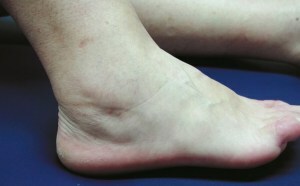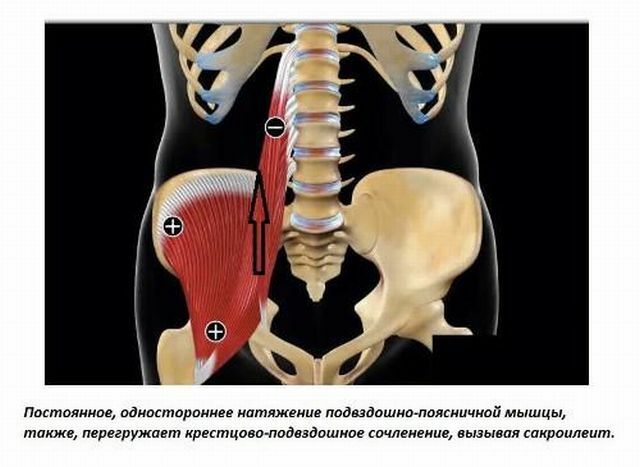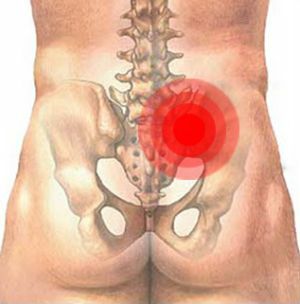 The inflammatory process of the sacroiliac joint is called sacroiliitis.
The inflammatory process of the sacroiliac joint is called sacroiliitis.
A person feels pain in the lower back. The disease can be independent or a symptom of some other diseases.
This joint is inactive. Sacrum - penultimate spine, below - coccyx. At birth sacral vertebrae are located separately from each other, they fuse after 18 years. A single bone is formed.
There is a congenital anomaly, called the back of the bifid, when the fusion is incomplete.
There are several forms of sacroiliitis, they depend on the cause, the nature of the process, its prevalence, they have different symptoms and flow.
The content of the article
- The more often the process is called?
- stages of the disease
- Symptoms and signs
- types and subtypes of the disease
- Pyogenic sacroiliitis
- When
- tuberculosis When
- syphilis When brucellosis
- Aseptic
- disease infectious nature
- diagnosis, radiographic signs
- Therapies
- Physiotherapy and massage
- Folk treatment
- Prevention: easierto warn, than to cure
Than most often process is caused?
Causes and risk factors:
- trauma;
- prolonged stress on the joint( pregnancy, weight-bearing, sedentary work);
- congenital malformations;
- tumors;
- metabolic disorders;
- infection;
- series of autoimmune diseases.
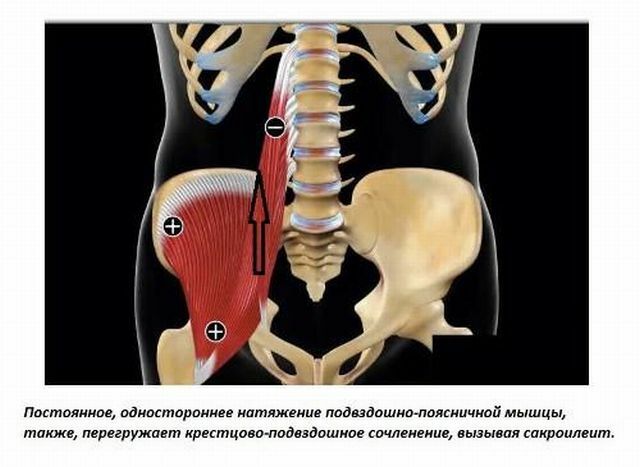
Stages of the disease
There are three stages of sacroiliitis:
- At the first , the symptoms are not pronounced clearly.
- When the second - there is pain in the buttocks, turning into the thigh. A frequent phenomenon is streaking, resi, having a paroxysmal character. Mobility is difficult.
- The third stage of the is very serious. There is radiculitis, cramps, pressure is rising.
Symptoms and signs
Symptoms are somewhat different for different types of disease.
Let's name the general:
- the main initial symptom of the disease is pain in the lower back;
- deterioration is observed in the peripheral joints;
- fatigue;
- subfebrile temperature;
- sometimes worsens vision;
- appears arrhythmia and other heart problems;
- mobility is limited;
- lumbago, attacks of pain.
Species and subtypes of the disease
Sacroiliitis is more often a one-sided disease, bilateral is sometimes observed in brucellosis, tuberculosis, necessarily - with Bekhterev's disease.
The following types are distinguished:
- Synovite .The synovium is inflamed.
- Panartite .The entire joint, all of its tissues, is inflamed.
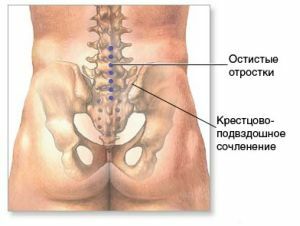
With sakroileitis there is a different nature of inflammation.
On this basis it is divided into:
- nonspecific( purulent),
- specific( with syphilis, tuberculosis, brucellosis);
- aseptic( for autoimmune diseases);
- non-infectious nature.
Purulent sacroiliitis
Causes may be different. A purulent focus can erupt, an infection of an open wound may occur. The onset of acute - chills, fever, sharp pains in the abdomen and back, excessive sweating, aches. The condition worsens.
The patient is standing, bending his legs in the knee and hip joints. In the field of the sacrum, a sharp pain, which is intensified when the leg is unbent. There is an increase in ESR and leukocytosis in the blood. Pus from the joint can break into the neighboring organs and form wounds.
Treatment is performed in the surgical department. At the initial stage - antibiotics, detoxification therapy. In difficult cases, surgery.
With tuberculosis
It is observed rarely, occurs more often chronically. The lesion can be one-sided and two-sided. In this case, the pain, the localization of which is difficult to determine, somewhere in the pelvic region and in the sciatic nerve.
Stiffness in movements. Deformations in the form of scoliosis are possible. Very often, hemorrhagic abscesses are formed in the thigh area, which are accompanied by fistula formation. Treatment is performed in the tuberculosis department.
Sometimes enough therapy, sometimes an operation is necessary.
With syphilis
With secondary syphilis it is quite rare. Usually in the form of arthralgia. Fast passes under the influence of antibiotic therapy. With tertiary there is synovitis or osteoarthritis.
Characterized by nocturnal, unsharp pain. Slight stiffness in movement. They are treated in the dermatovenerologic dispensary.
With brucellosis
Usually temporary, volatile arthralgia. Sometimes there is persistent inflammation, and it is difficult to treat. The patient complains of pain in the sacrum, which becomes unbearable during movement.
It is impossible to bend and unbend the spine, the body is chained. There is a symptom of Lasega. This, when trying to raise a straightened leg, pain on its posterior surface increases.
Treatment is conservative. In chronic course, physiotherapy is indicated. Spa treatment helps.
Aseptic
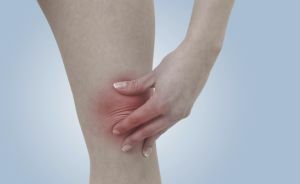 It happens in the presence of rheumatic diseases, for example, with psoriatic arthritis, Reiter's disease.
It happens in the presence of rheumatic diseases, for example, with psoriatic arthritis, Reiter's disease.
In Bekhterev's disease, early diagnosis is important, as treatment in this case begins in a favorable period - before the fusion of the vertebrae. Clinical manifestations are not bright.
Weak pain in the buttocks, giving back to the thigh. In a state of rest it hurts more strongly, at walking weakens. Morning stiffness, gradually disappearing.
If the diagnosis of sakroileitis is confirmed by X-ray and other studies, treatment is prescribed - complex therapy. These are anti-inflammatory drugs, physical education, physiotherapy, sanatorium.
Disease of non-infectious nature
Occurs in connection with joint dystrophy. It is not considered a bright representative of this disease.
In this case, there are either arthrosis changes in the joint, or inflammation of the sacroiliac ligament. The diagnosis is such - sakroileit obscure etiology.
Changes are caused by injuries, overload of the joint. It can be pregnancy, playing sports and so on. With a disturbed posture, the risk of this pathology increases. The pain is spasmodic, spontaneous.
The symptom of Fergason is pathognomonic for this disease. The patient should stand on a healthy chair, then a patient with a foot. You should also leave - first a healthy, then a painful leg. The pain in the sacrum indicates a disease. Treatment removes inflammation and pain.
With severe pain, blockades are made.
Diagnostics, X-ray signs
It is necessary to consult an orthopedic trauma specialist. After the examination, analyzes are prescribed and necessarily - X-ray examination.
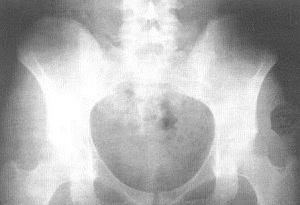
In the photo, bilateral sakroileitis
With it, changes in the joint will become noticeable. There may be bone thickening, blurred contours, erosion, narrowing of the joint gap and even its absence. But not everything can show the roentgenogram.
For example, with synovitis, changes are not detected on it. The same is true for brucellosis sakroileitis, although the remaining symptoms are clearly pronounced.
All tests are taken into account in the diagnosis. In the first place, the patient is examined, his anamnesis, gait, tone, and so on are studied.
Treatment methods
Treatment and prognosis depend on the causes of the onset and the form of development. With aseptic sacroiliitis, treatment is conservative, with purulent often it is necessary to do without surgery.
Pregnant appoint a special bandage to reduce the burden on the affected joint. If the pathology is a consequence of another disease, in the first place it is treated. If the background is traumatic, the injury must be cured, the joint is fixed.
Therapeutic gymnastics and massage
In an acute period, this is not the case. It requires a restriction of mobility. And during the remission requires physical exercise in mild form.
Ideal if you can practice yoga or aquafitness. Massage is also useful. It is done every 2-3 days. After doing a compress of sea buckthorn oil or rub bischofite.
Folk treatment
For example, such recipes:
- It is recommended to take an empty stomach 0.3% solution mummy. Twice a day for 20 ml.
- Or advise to take powder from the egg shell. Pollogram in the evening 2 hours before dinner.
This treatment will not eliminate the cause of the disease, its consequences, it can be used as a supporting agent. Seriously, only a doctor can help.
Prevention: it is easier to prevent than cure
 An important and necessary step is the prevention of the disease. The main thing is to maintain immunity. It is necessary to treat infectious diseases, without waiting for the complication of the joints. Moderate sports are important.
An important and necessary step is the prevention of the disease. The main thing is to maintain immunity. It is necessary to treat infectious diseases, without waiting for the complication of the joints. Moderate sports are important.
With sedentary work - warm-up from time to time. If the joint is sick, it can not be overloaded. An urgent visit to the doctor and the implementation of all his recommendations are necessary.
Back pain is not a pleasant phenomenon. In addition, it signals a danger. We must stop, listen, go to the doctor, take the necessary measures. Then you will redo all your business. When the back is healthy and the mood is joyful.


